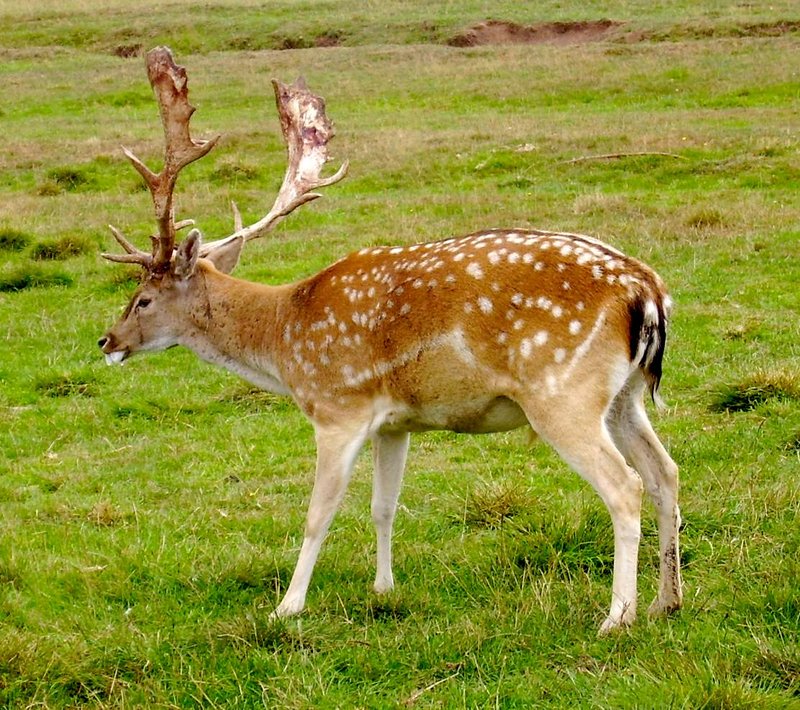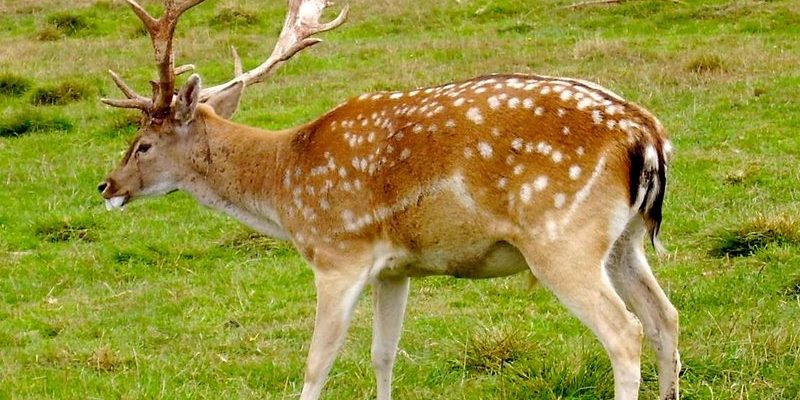
When you think of deer, you might picture the graceful white-tailed deer bounding through a sun-dappled forest. But have you ever heard of the fallow deer? These charming creatures, with their distinctive features and gentle demeanor, are a delightful part of the deer family. Imagine a deer that combines elegance with a hint of whimsy, flaunting its spotted coat and unique antlers. It’s no wonder that these animals have captivated hearts and minds alike!
The fallow deer (Dama dama) stands apart not just for its looks but also for its fascinating habits and adaptations. Often found grazing in the lush meadows of Europe and parts of Asia, these deer exhibit intriguing behaviors that both enchant and educate those who take the time to observe them. Whether you’re an avid wildlife enthusiast or just curious about the wonders of the animal kingdom, getting to know fallow deer can be an enjoyable experience.
Physical Characteristics
The fallow deer is easily recognizable thanks to its unique body shape and coloration. They typically have a slender build with long legs, making them agile sprinters. The most striking feature is perhaps their coat, which varies from a rich chestnut brown to a light gray. Many fallow deer have white spots scattered across their bodies, reminiscent of a starry night sky. This beautiful coloring helps them blend into their woodland surroundings, giving them an advantage against predators.
When it comes to size, adult male fallow deer, also known as bucks, weigh between 150 to 250 pounds, while females, known as does, are generally lighter, ranging from 90 to 150 pounds. Bucks are distinguished by their impressive antlers, which can grow up to three feet long and have a flat, palmate shape, resembling a wide paddle. The antlers are shed annually, and their growth is a vital part of the deer’s life cycle, influenced by seasonal changes and hormones.
Overall, the fallow deer’s combination of size, striking coloration, and graceful movements create a spectacular sight in the wild. Whether they’re bounding through fields or resting in the shade of a tree, their beauty is undeniable and makes them a favorite among wildlife watchers.
Habitat and Distribution
Fallow deer are native to Europe and parts of Asia but have been introduced to various regions around the globe, including Australia and New Zealand. They thrive in a variety of habitats, including open woodlands, grasslands, and even park-like landscapes. These deer prefer areas that offer a mix of cover and open space, allowing them both safety from predators and easy access to food.
In their natural habitat, fallow deer often gather in groups known as herds. These herds can be quite dynamic, with females tending to stay in core groups while males may roam more freely, especially during the rutting season when they compete for mates. The social structure of fallow deer is fascinating as they exhibit complex behaviors, including grooming and vocalizations that strengthen bonds within the herd.
As you explore the habitats of fallow deer, you might notice their preference for areas with abundant forage, such as lush grasses, fruits, and leaves. This availability of food is crucial for their survival, especially during the colder months. Their adaptability to different environments is one of the reasons they have thrived in both wild and cultivated areas, making them a common sight in many parks and reserves.
Diet and Feeding Habits
Fallow deer are herbivores, primarily feeding on a diet of grasses, leaves, flowers, and shrubs. Their grazing habits play a vital role in their ecosystems, as they help maintain the balance of plant life. The shape of their teeth and digestive systems allows them to efficiently process fibrous plant matter, extracting the nutrients they need to thrive.
One interesting aspect of fallow deer feeding behavior is their selective grazing. They seem to have a preference for certain plants over others, often opting for the tastiest greens available. This selectivity can sometimes lead to conflicts with farmers, as fallow deer may be drawn to crops and gardens. However, their role in natural vegetation management is generally beneficial, keeping plant overgrowth in check.
In addition to grazing, fallow deer also exhibit browsing behavior, which means they’ll stretch their necks to reach higher foliage, contributing to their varied diet. During the warmer months, these deer are often more active in seeking food, while in winter, they rely on stored fat reserves and may venture further from their usual grazing spots to find sustenance. This adaptability in their feeding habits helps them survive in fluctuating conditions.
Behavior and Social Structure
Fallow deer are social animals that thrive in herds, which can include anywhere from a few individuals to over a hundred, depending on the habitat and time of year. The herd structure is usually matriarchal, with females leading the group and males establishing their dominance through displays of strength. You might find it fascinating how these deer communicate with each other using a range of vocalizations, body language, and even scent marking.
The mating season, or rut, is a particularly exciting time for fallow deer. Typically occurring in late autumn, the males engage in fierce competitions for mating rights. They display their antlers, engage in mock fights, and emit deep bellows that resonate through the forest. This behavior is not just a means of courtship but also serves to establish hierarchy within the herd. Watching these rituals can be like witnessing a captivating performance in nature.
During the rest of the year, fallow deer often engage in playful activities, such as sparring with each other, chasing one another, or simply lounging in the sun. Their social interactions are crucial for the development of young fawns, who learn important survival skills through play and imitation. This nurturing aspect of their behavior reflects a deeper bond and understanding of community among these elegant creatures.
Reproduction and Lifespan
Fallow deer have a distinct breeding season, typically occurring between October and November, known as the rut. During this time, male deer will engage in various displays to attract females. After a successful mating, the gestation period lasts about 240 days, culminating in the birth of one to two fawns in the spring. These fawns are born with a spotted coat, which provides excellent camouflage against predators.
As the fawns grow, they remain close to their mothers, learning to graze and navigate their environment. This maternal bond is vital for their survival, as the mother teaches them to identify threats and find food. By the time they’re around six months old, the fawns are weaned and begin to explore independently, still staying close to the herd.
In the wild, fallow deer can live up to 10-12 years, but factors like predation, habitat loss, and disease can impact their lifespan. In protected environments, like parks or reserves, their lifespan can extend even further, allowing them to thrive free from many of the dangers they face in natural settings.
Conservation Status
While fallow deer are widespread and not currently considered endangered, they face challenges due to habitat loss and human activities. Urban expansion and agricultural development have fragmented their natural habitats, making it harder for them to find food and mates. Conservation efforts are essential to ensure their populations remain stable and healthy.
Many wildlife organizations focus on preserving habitats and educating communities about the importance of these deer in ecosystems. By promoting coexistence and responsible land use practices, we can help protect fallow deer and their environments for future generations. In some areas, fallow deer are even managed through controlled hunting to maintain healthy populations.
Observing fallow deer in their natural habitats can ignite a passion for wildlife conservation in many people. As we learn more about these beautiful creatures and their roles in our ecosystems, we gain a deeper appreciation for the need to protect both wildlife and their environments.
Interesting Facts about Fallow Deer
| Scientific Name: | Dama dama |
| Size: | Adults weigh 90-250 pounds |
| Height: | Approximately 3-3.5 feet at the shoulder |
| Habitat: | Woodlands, grasslands, parks |
| Diet: | Herbivore, primarily grasses and leaves |
| Life Span: | 10-12 years in the wild |
| Antler Growth: | Male antlers are shed annually |
FAQ
What do fallow deer eat?
Fallow deer are herbivores and primarily feed on grasses, leaves, flowers, and shrubs. Their diet changes with the seasons, as they take advantage of the diverse plant life available throughout the year. In the spring and summer, they tend to prefer tender greens, while in the colder months, they may graze on tougher vegetation.
Are fallow deer dangerous?
Generally, fallow deer are not dangerous to humans. They are shy and prefer to avoid contact. However, like all wild animals, they can become defensive if threatened or cornered. It’s best to observe them from a distance and avoid any interactions that might cause stress.
How fast can fallow deer run?
Fallow deer are surprisingly agile and can reach speeds of up to 30 miles per hour when fleeing from predators. This speed, combined with their ability to make sharp turns, helps them evade threats in their natural habitat.
Do fallow deer live in groups?
Yes, fallow deer are social animals that typically live in herds. These groups can vary in size and composition, often consisting of females, their young, and a few males. Social interactions within the herd play a crucial role in their behavior and survival.
How do fallow deer communicate?
Fallow deer communicate through a variety of vocalizations, body language, and scent marking. They may grunt or bleat to convey messages to each other, especially during the breeding season. Their postures and movements can also indicate excitement, stress, or contentment.
What is the mating season for fallow deer?
The mating season, known as the rut, typically occurs in late autumn. During this time, males compete for the attention of females through displays of strength and vocalizations. The rut is an exciting period, showcasing their unique behaviors and social dynamics.
How can I observe fallow deer in the wild?
To observe fallow deer in their natural habitats, visit national parks, wildlife reserves, or areas where they are known to roam. Early morning or late afternoon are the best times for sightings, as deer are crepuscular and more active during these hours. Always maintain a respectful distance to avoid disturbing them.
Are there different types of fallow deer?
Indeed, fallow deer have several subspecies, including the European fallow deer, the Persian fallow deer, and the American fallow deer. These subspecies vary in size, coat color, and habitat preferences, showcasing the diversity within the fallow deer family.
Can fallow deer be domesticated?
While fallow deer can be raised in captivity for agricultural purposes, they are still wild animals with specific needs. Domesticated fallow deer are often kept in enclosures or estate parks but require appropriate care and management to thrive. It’s essential to recognize their natural behaviors to provide the best environment for them.
What is the conservation status of fallow deer?
Fallow deer are not currently considered endangered and are classified as “Least Concern.” However, they face threats from habitat loss and environmental changes. Conservation efforts are vital to maintain healthy populations and preserve their natural habitats.
How long do fallow deer live in the wild?
In the wild, fallow deer typically live up to 10 to 12 years. However, in protected environments, such as wildlife reserves, they can sometimes live longer due to the absence of natural predators and a stable food supply.

